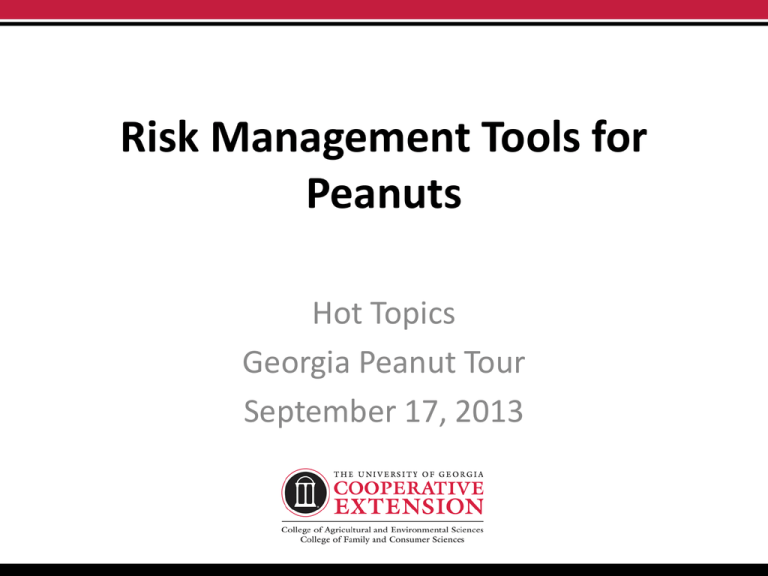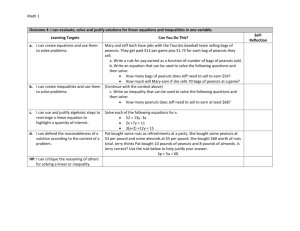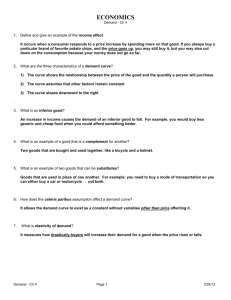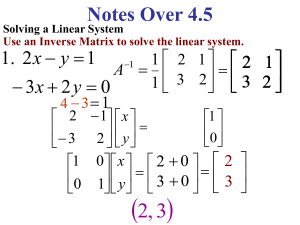Risk Management Tools for Peanuts Hot Topics Georgia Peanut Tour
advertisement

Risk Management Tools for Peanuts Hot Topics Georgia Peanut Tour September 17, 2013 What is Risk in Agriculture? • Agricultural producers profit when the revenue generated from production exceeds the costs of production. Uncertainty of revenue can be defined as risk. • Born out of this uncertainty is the possibility of injury or loss. • Risk can be defined as the possibility of adverse outcomes due to uncertainty and imperfect knowledge in decision making. Agricultural Risk Categories • • • • • Production Marketing Financial Legal Human Resources Risk Categories • • • • • Production Marketing Financial Legal Human Resources Production Risk • Weather - drought, excessive heat, hail, excess moisture, wind, frost, freeze. • Pests – insects, parasites, wildlife • Diseases • New Technology • Machinery Efficiency • Availability, Quality and Efficacy of Inputs Risk Management Tools • Irrigation • Crop Insurance • Enterprise Diversification and Rotations • Government Programs • Hiring Custom Operators • Excess Capacity • Contract production (vertical integration) • Precision Ag • Transgenic Seed • GMOs • Lease Arrangements • Applied Research and Extension Risk Management Tools for Peanuts • Irrigation • Crop Insurance • Enterprise Diversification and Rotations • Government Programs • Hiring Custom Operators • Excess Capacity • Contract production (vertical integration) • Precision Ag • Transgenic Seed • GMOs • Lease Arrangements • Applied Research and Extension Irrigation – 2013 Peanuts State % Peanuts Irrigated 4% ALABAMA 99% ARKANSAS 29% FLORIDA 51% GEORGIA 8% MISSISSIPPI 100% NEW MEXICO 1% N CAROLINA 96% OKLAHOMA 15% S CAROLINA 96% TEXAS 1% VIRGINIA Source: FSA Crop Acreage, September 17, 2013 Acres Irrigated 5,744 11,621 38,662 217,520 2,731 7,185 440 15,861 12,040 110,452 121 Crop Insurance • Individual Multi-peril Crop Insurance (MPCI) – Yield – Revenue (introduced in 1996) • Area MPCI – Yield Index based on NASS county yields – Revenue Index • Private Supplemental Coverage – Hail, Wind, Fire Combo Policy • Crops with futures contracts have the choice of Combo Policy in which producer can choose between: – Yield Protection – Revenue Protection – Revenue Protection with Harvest Price Exclusion • Commodity exchanges determine the projected price used to establish the insurance guarantee and premium Peanuts • Yield Protection – Actual Production History (APH) policy that triggers when actual yield falls below APH guarantee yield. (old MPCI) – Varying coverage levels of price and yield ranging from 50% to 85% – Units • • • • Basic Optional Enterprise Whole Farm Who Participates in the U.S. Crop Insurance Partnership? Acres enrolled, 1 dot-20,000 Premium by major crop: 2008-09 Source: Collins, K. 2009 Presentation: “Future of Crop Insurance in Volatile Markets”. Crop Insurance Participation - GA Crop State Cov Ins Delive Pol Sold Pol Pol Units Units Net Liabilities Lvl Plan ry Earn Indem Earn Indem Acres Prem Prem PEANUTS GEORGIA 50 APH RBUP 492 172 1 360 2 19,365 9,029,275 PEANUTS GEORGIA 50 APH RCAT 1,145 405 0 622 0 77,352 21,547,520 PEANUTS GEORGIA 55 APH RBUP 72 27 1 70 2 4,047 2,072,114 PEANUTS GEORGIA 60 APH RBUP 530 183 4 539 6 23,486 12,289,685 PEANUTS GEORGIA 65 APH RBUP 2,303 804 13 2,208 26 89,891 48,806,170 PEANUTS GEORGIA 70 APH RBUP 3,013 996 24 2,696 32 123,676 71,780,945 PEANUTS GEORGIA 75 APH RBUP 1,398 402 9 1,048 10 51,454 33,159,913 PEANUTS GEORGIA 80 APH RBUP 196 65 3 208 7 16,096 13,295,959 PEANUTS GEORGIA 85 APH RBUP 11 6 0 9 0 9,160 3,060 55 7,760 Grand Total 310 187,322 85 405,677 212,168,90 3 Crop Insurance Shortcomings for Peanut Growers • • • • • No Revenue Policy Not a good safety net for low price periods Heterogeneous fields and soil types Combination of irrigated and non-irrigated acres Increase use and popularity in Midwest among corn and soybean farmers is due to: – Revenue Insurance – Lower premiums due to discounts for trend adjustments, enterprise units, good yield histories until last year. – Historically high prices Peanut Marketing Tools • • • • Marketing Contracts Marketing Assistance Loan Marketing Cooperative Cooperative or Growing Owned Processing Marketing Contracts • Option Contract – Sheller pays the grower an option premium above the loan rate of $355 per ton in order to have the right to purchase the growers peanuts. – $145 option premium plus $355 loan rate gives the grower $500 per ton base grade for peanuts. – Contracts can have clauses and specifications such as delivery, when payment is received, tonnage or volume contracted, right to buy additional production, shrink, storage, option expiration, etc.. Marketing Contracts • Flex Price Contract – Base price per ton tied to shelled price. – Like a minimum price contract with grain or cotton. – Grower has a period of time to price peanuts after delivery. – Limit on price. • Pool Contract – Share in the profits of the similar to a marketing pool. Can have a range of low and high price. Marketing Assistance Loan • 9 Month Loan • $355 per ton • Handling and storage costs are paid by CCC up front and reimbursed when peanuts are redeemed from the loan. • Can be forfeited and CCC eats the handling and storage costs and markets the peanuts after expiration. Cooperative & Grower-Owned Processing • Cooperative pools peanuts and sells to sheller, sharing the profits with members. – Receive $355 up front and patronage is paid later in the year. • Grower-owned shellers - members obligated to deliver peanuts equal to stock shares and price received depends on profits of the sheller. • These strategies don’t necessarily bring the grower the best price, or lowest price. Summary • Peanut growers have tools at their disposal to help manage risk but they are limited compared to grains and cotton due to lack of a futures exchange for peanuts. • Working with limited information on price. • Irrigation and adoption of technology are strategies being used to reduce risk. • Crop insurance is heavily utilized but not really a safety net.






